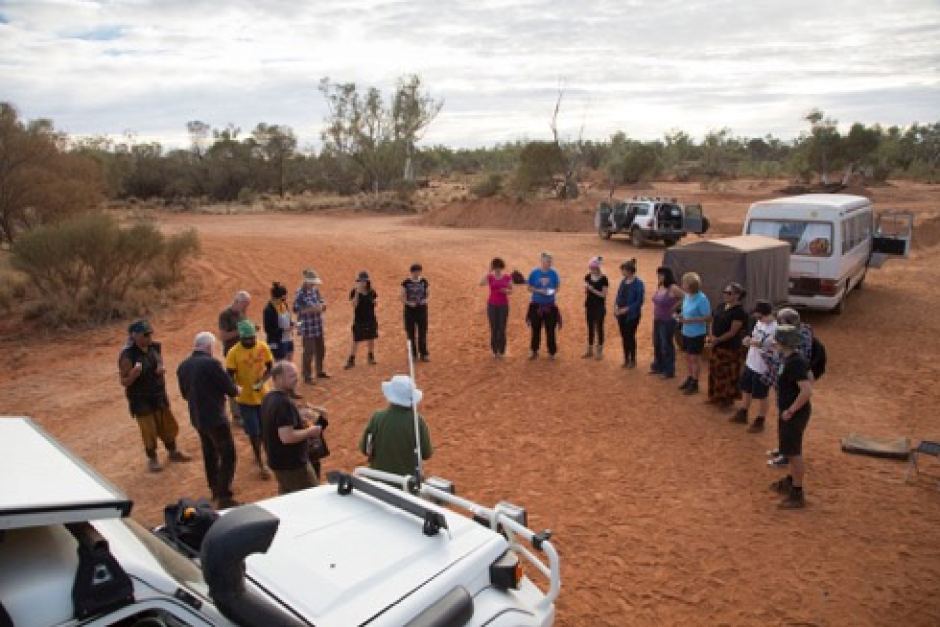Category: Mining Industry / Indigenous (Aboriginal and Torres Strait Islander) / Environmental Impact
Martu people in long march against WA uranium mine
Saturday, 4 Jun 2016 13:04:40 | Angus Sargent

Protestors gathered in Newman on Saturday to travel to Parnngurr for the walk. (Supplied: Tobias Titz)
The Martu people from Indigenous communities in WA's Pilbara region are setting off on a week-long March to protest against a proposed uranium mine.
Residents from Parnngurr and surrounding communities will walk about 140 kilometres to the site of Cameco Australia's Kintyre project.
The Canadian-owned company received conditional approval last year from both the WA and Federal governments to develop the mine, approximately 270 kilometres north-east of Newman.
Indigenous leaders from nearby communities are concerned the project will affect their water supplies as well as 28 threatened species in the Karlamilyi National Park.
Elder Nola Taylor said the development represented a threat to the health of people in her community.
"It's (the mine) too close to where we live, it's going to contaminate our waterways, we've got our biggest river that runs right past our community," she said.
"They (Cameco) told me it would be safe, they said all that but we had a cyclone go through here a couple of years back, and for me I have seen what has happened to the river and the water that is in there.
"I'm going to walk with the rest of the community to fight and stop the uranium mine that's going to go ahead."
The joint-venture with Mitsubishi Development would include a range of facilities including an airstrip, processing plant, waste-rock dump and tailings storage facility.
Cameco said it was currently preparing the project for improved market conditions.
Concerns uranium waste is unsafe
But Curtis Taylor, a Martu man and filmmaker, who will take part in the walk, is not convinced the waste can be stored safely.
"We had assurances given to us by the company but everyone still has that worry, if there was a flooding event that maybe tailings would go into the river," he said.
Mr Taylor said the community had been fighting against the construction of the mine for several years.
"This is an old fight that's reignited from the late '80s early '90s from when the previous company was drilling and exploring around that area," he said.
Several years ago, nine artists from the Parnngurr community created an artwork called Kalyu to highlight the area's story and their opposition to the mine.
The painting was purchased in 2014 by the Museum of Contemporary Art in Sydney, and the WA Nuclear Free Alliance will sell prints of it to raise money for the campaign.
 Photo:
Martu artists created the Kalyu artwork to raise awareness of their concerns. (Supplied: Martumili artists)
Photo:
Martu artists created the Kalyu artwork to raise awareness of their concerns. (Supplied: Martumili artists)
Miner says communities were consulted
Cameco Australia managing director Brian Reilly said there had been a long consultation period with nearby communities.
"In 2012 Cameco and Martu signed an Indigenous Land Use Agreement," Mr Reilly said.
"The agreement was a culmination of more than three years of relationship building and negotiations.
"We have consulted widely with the Martu people about the Kintyre project.
"We believe that the communities near Kintyre are generally supportive of the project, and we will continue to work with them on heritage matters and training and employment opportunities."
- About Us
- |
- Terms of Use
- |
-
 RSS
RSS - |
- Privacy Policy
- |
- Contact Us
- |
- Shanghai Call Center: 962288
- |
- Tip-off hotline: 52920043
- 沪ICP证:沪ICP备05050403号-1
- |
- 互联网新闻信息服务许可证:31120180004
- |
- 网络视听许可证:0909346
- |
- 广播电视节目制作许可证:沪字第354号
- |
- 增值电信业务经营许可证:沪B2-20120012
Copyright © 1999- Shanghai Daily. All rights reserved.Preferably viewed with Internet Explorer 8 or newer browsers.




 Send to Kindle
Send to Kindle